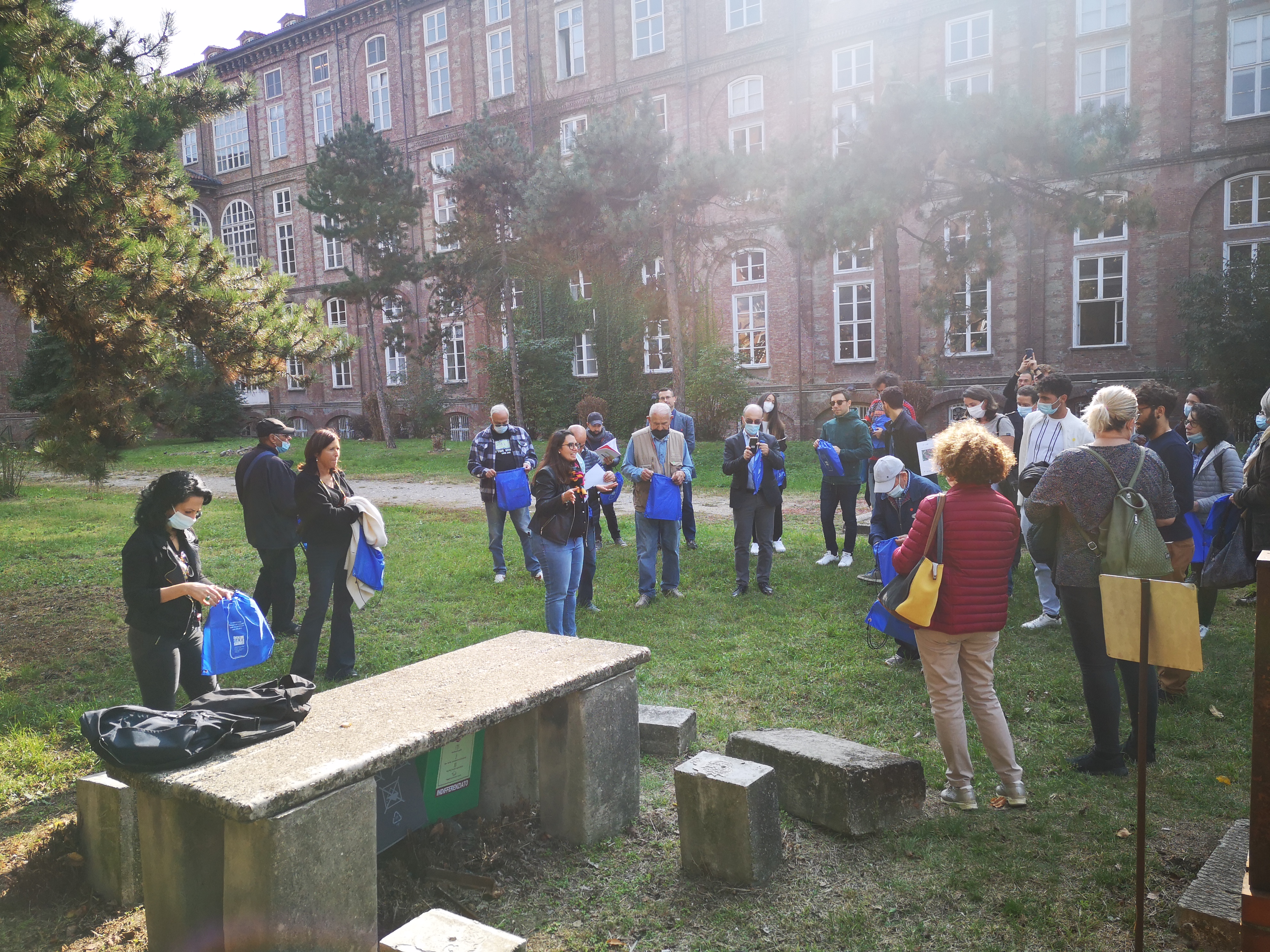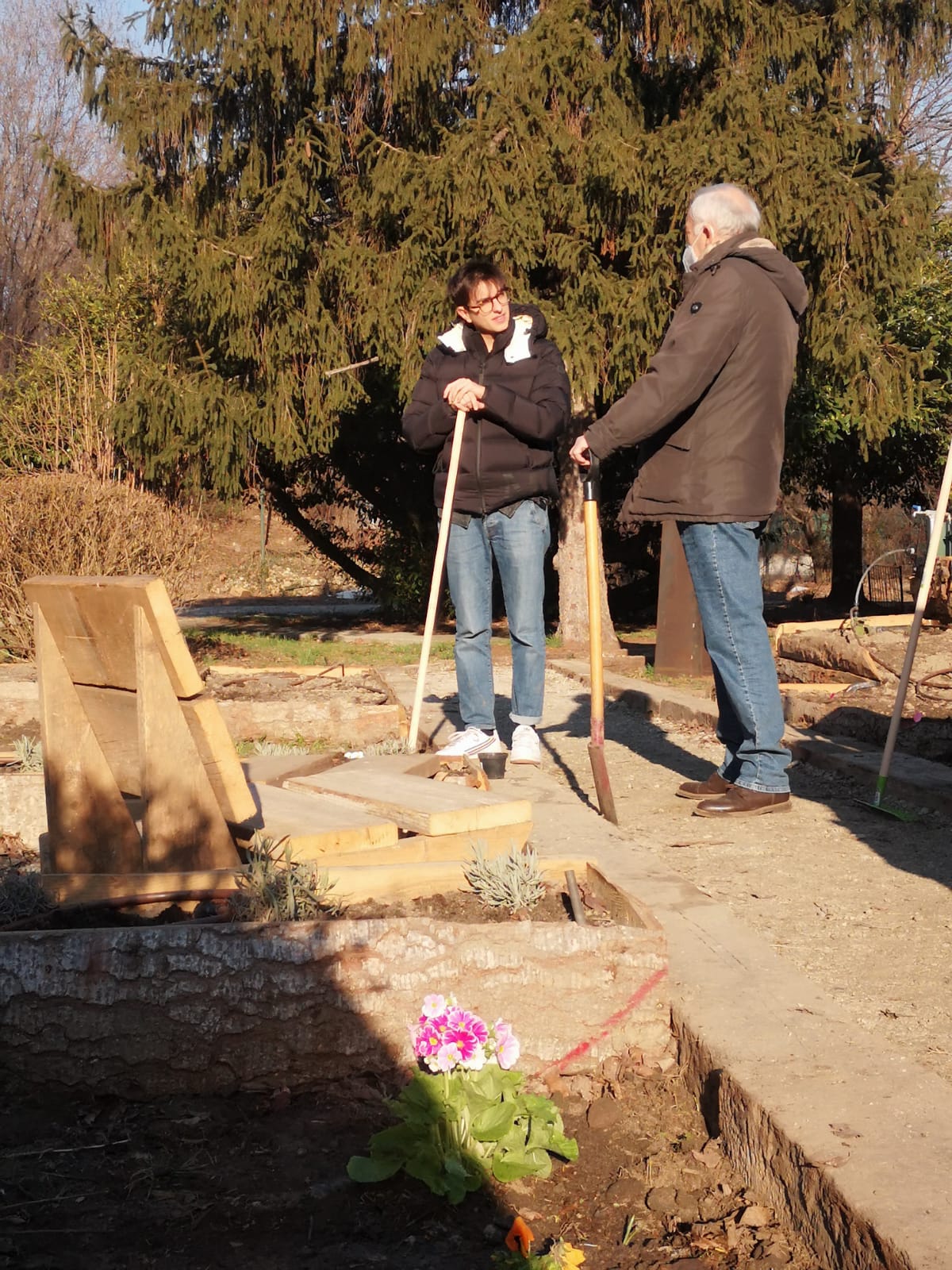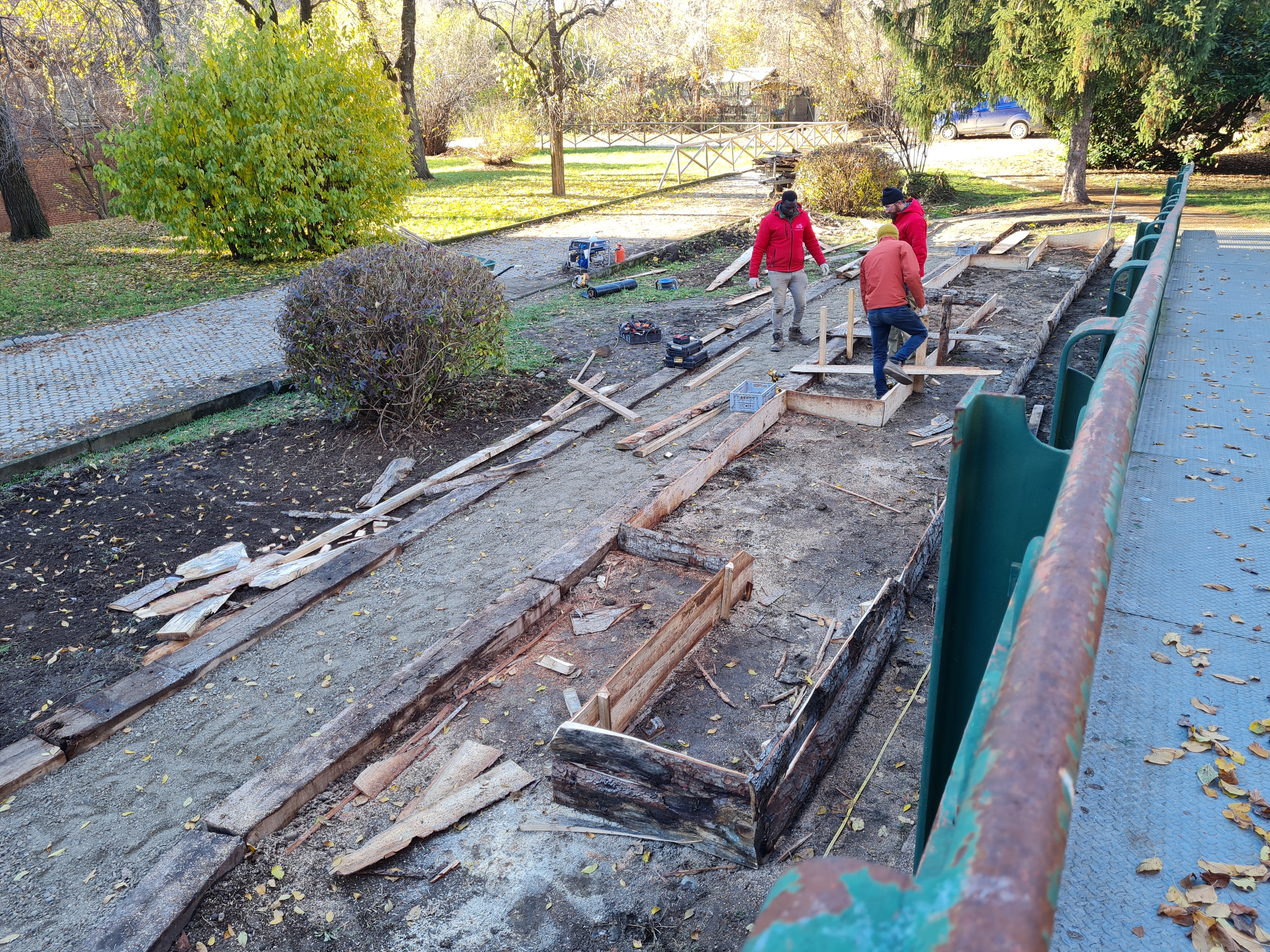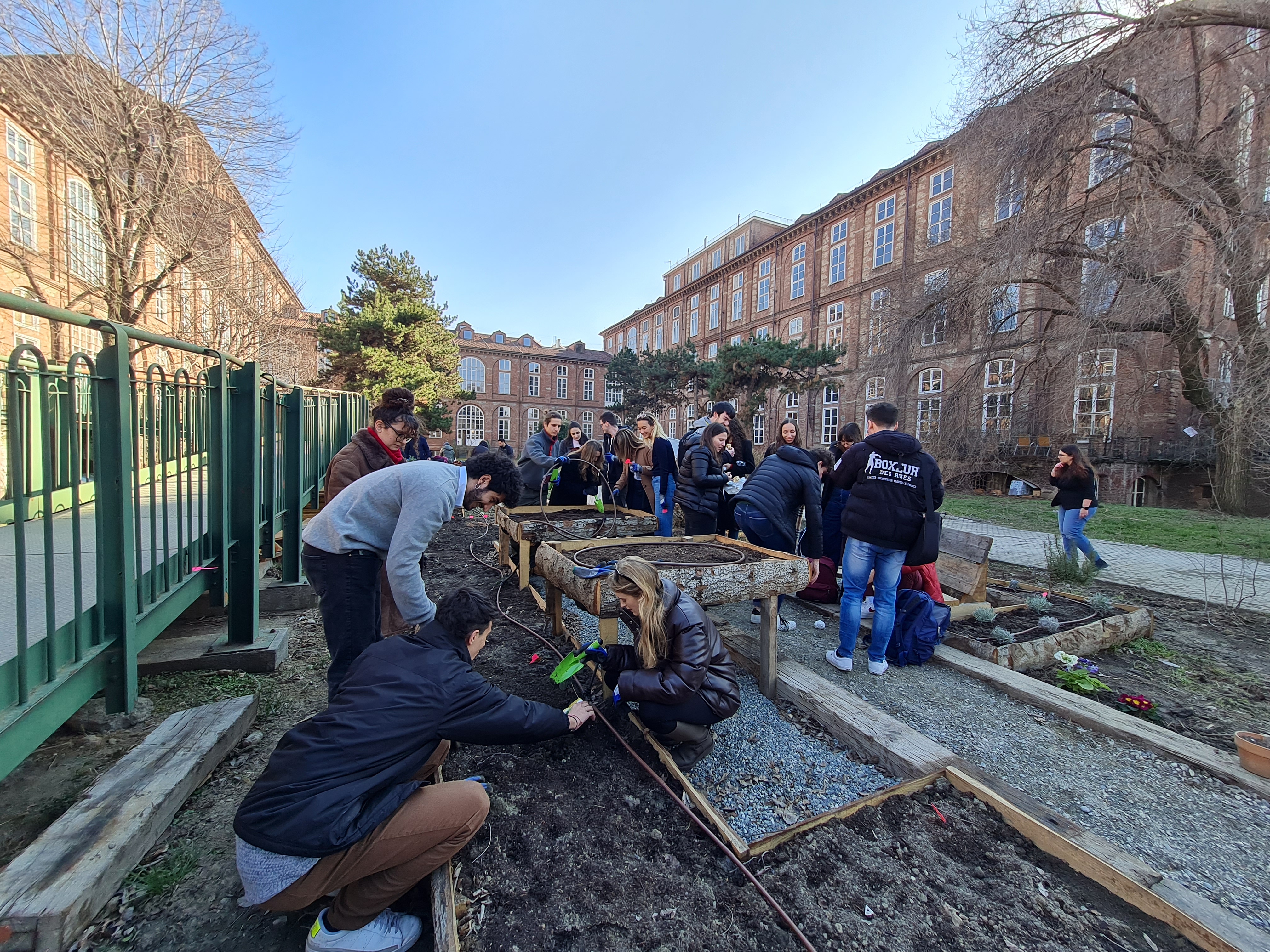Orto della SME has been a requalification of an university’s open space through a co-planning process involving a vibrant university community, CSOs and NGOs, retired citizens, and the municipality of Turin. The project created an accessible and sustainable collective gardening site, enhancing academic citizenry and citizens’ sense of belongingness in connection with the urban nature, supporting the aesthetic requalification of the area and seeding circular and solidal economic circles
The project has been funded by EIT Food Cross-KIC citizens engament.
The project was built around the co-creation of a university public space, open to the citizens, by installing container gardens, following the criteria of the New European Bauhaus at all stages of the project, from the design to the management of the garden. According to NEB principles, the project has been rooted in pillars such as: "Inform and exchange", "Inspire and aspire" and "Engage and co-create". The container gardening project (Orto alla SME) involves citizens and university citizenry to produce fruits and vegetables ready for consumption. The area has been identified and finally restored and converted into an urban garden of more than 200m2 (removing 850 kg of waste). Although the mere practical intervention, a more sophisticated process of multi-stakeholder engagement was at the core of the project. Two communities have been mainly involved. The stakeholders frequenting the university area (students, professors, technical and administrative staff), in one of the main campuses of the University of Turin (the School of Management and Economics, acronym SME). The second community involved has been composed of citizens of the neighborhoods surrounding the University, retired, disabled, and visually impaired, a kindergarten. The key principles guiding the project are social inclusion and equality, production of healthy food in urban areas as a means of raising awareness of the need for more sustainable consumption, exchange of good practices between different communities to promote the empowerment of the parties involved and encourage an intra- and intergenerational flow of knowledge, and sustainability as a strategy for redeveloping spaces and places. In addition, the principle of circular economy has been included and respected in the project, with the use of recycled and renovated materials to build up the containers. Cultivations, the size of the container have been co-decided and historically re-discovered involving the retired.
Please highlight how the project can be exemplary in this context
To design the aesthetic of the container garden, it was essential to work with an environmental and landscape architects, able to understand how to combine social inclusion, sustainability, and circularity. The choice of the building materials has been critical as in the current period, the wood price has increased and even second-hand building materials are scarce, because the recovery fund has financed the renovation of private buildings, that in turn has meant that the materials were scarces. Working according to circular economy principles has therefore required activating and discovering new connections with construction sites, sawmills, and warehouses, recovering the material, always adapting it in the name of aesthetics. In this sense, the project was ambitious in having decided not to adopt virgin materials and to safeguard virgin timber.
For the technical realization of the infrastructure and the furniture, train sleepers were recovered (suitably treated), as well as waste wood from local sawmills and green building sites that would otherwise have become waste. The wood used to create the walkway through the gardens was made by recovering 22 quintals (3 cubic meters), or 28 sleepers, of oak railway sleepers. The planks used to make the caissons are made of wood recovered from building sites and carpentries in Turin. This allowed us to recover 15 quintals of wood, equal to 2 cubic meters, mostly bark from larch and fir trees. The tool shed, table and benches were made by recovering and reassembling existing components from unsold building site waste. It has been estimated that this project has saved about 52 to 60 quintals of virgin wood and extended the life cycle of various products and raw materials. The estimate was made taking into account the percentage of raw material that would be lost during forest management, and the different stages of cutting, transport. In addition, more than 850 kg of waste have been removed before the installation.
Please highlight how the project can be exemplary in this context
The area in question was a marginal area, enclosed between university buildings, not used at all by the university community, but accessible to the public. The project therefore aimed to transform a space by implementing Nature-based Solutions (specifically vegetable gardens in boxes) that provide numerous ecosystem services (including cultural services linked to aesthetic quality), making it usable and aesthetically pleasing. The transformation of the area in question and the creation of the vegetable gardens in boxes was focused on the recycled materials from construction sites, sawmills and warehouses to meet the principles of the circular economy and with a high aesthetic value. The aim of reusing materials that would otherwise have become waste has made it possible to reduce the consumption of virgin material and safeguard the use of virgin timber by aesthetically enhancing the imperfections of the materials. The wooden materials used are integrated into the space in which the garden is located, blending into the landscape and reducing the visual impact of the project. The imperfections and uniqueness of the raw materials used have thus become a distinctive element of the project, metaphorically recalling the close bond between man and natural resources. The aesthetic profile of the buildings is reminiscent of a post-industrial site, and the project has rediscovered a wonderful corner of the garden (the Fondo per l'Ambiente Italiano has shown interest). In addition, aesthetics has become a design variable for social inclusion, as the design of the structures contemplates the needs to create social spaces (armchairs), growing spaces for the motor disabled and visually impaired, children's spaces with low walls, tables that can be moved. The design of the places has been done collaboratively during the three multi-stakeholder forum.
Please highlight how the project can be exemplary in this context
Inclusion is a fundamental pillar of the project. Various initiatives and strategies have been developed to meet accessibility criteria for people with disabilities (in particular wheelchair users and blind people), to encourage the participation of the university community and external stakeholders with a view to transferring experience and knowledge, and to develop a co-design process capable of giving life to a project that was the result of different points of view and different needs. The activities that led to the creation of the garden began in August and over the three months of co-design have seen the active involvement of more than 60 people.
The discussion tables were designed democratically to include and engage diverse groups of stakeholders, regardless of "institutional" importance, so organizational figures from the university worked closely with citizens. Students also created a great relationship with retirees who currently have allotments in a neighboring area.
In order to improve the accessibility of the area and allow the disabled population better accessibility, walkways and caissons were designed to be walked and used by a population with motor disabilities. Lower, narrower boxes were designed to involve children from neighboring schools. The history of the garden and its rules are also available in audio format, for the blind and visually impaired population, accessible by smartphone through a QR Code. In addition, the totem pole created to explain the project was designed to communicate in an inclusive way to a non-academic citizenry, the objectives of the project, and the methods implemented principles and logic. The use of a graphic narrative with comic strips is deliberately necessary to make the whole project more accessible to citizens. Social media channels have been hardly used to vehiculate the information and the events.
Please highlight how this approach can be exemplary
The project has been carefully performed to achieve most of the benefits urban gardening can bring to local communities, via the high-quality experience of co-planning and co-design of the shared urban public space. The Orto della SME builts on sustainability principles, including the idea that there is no universal “green” pathway to ecological sustainability, as this is context-specific, but social justice is an intrinsic element in any coherent route. Therefore, together with devoting care and attention to the selection of species, and with collectively discussing plantation and harvesting plans to respect local biodiversity and support the ecological function of the area, the Orto della SME participants engaged with contributing to broader social cohesion and inclusion agenda. This included attentive consideration for all the potentially interested social groups and their involvement from the very initial phases of the project, constant attention to communication and listening via dedicated social media and traditional channels to promote active engagement in an active and healthy lifestyle who can benefits also those people living in the suburbs of a post-industrial city and have less access to solidarity link and community ties. The initiative focused on the realization of a project that would respond to the three principles of the NEB: quality of experience, sustainability and inclusion. Inspired by these principles, the project was carried out by organizing various exchanges involving the active participation of various stakeholders from inside and outside the university. The idea of conceiving a public university space, in a school of management, with a focus on the human-nature connection has created a new sense of shared responsibility. The space has been transformed into a meeting place where students can lecture in the garden and take an interest in their crops. The retired growers are excited to share their knowledge to students.
The project had different impacts on different perspectives. From the point of view of the creation of a university community, it can be said that the involvement of student and professor representatives, including the directors of the departments and the School, meant that a stronger sense of collaboration was felt, when compared to the situation at an early stage.A second impact was determined by the moments of encounter with citizens and retired, who also admitted that they saw the need to create a community in this specific area as more necessary, and to have the perception of the university as a respectable institution and from which a greater involvement of the citizenship itself is expected. Finally, there is an impact related to biodiversity. The transformation of the area included the planting of numerous fruit and vegetable species, which attract pollinators and birds. This biodiversity aspect is also fundamental from an educational/cultural point of view. Compared to the perspective more connected to food production, it emerged that the contribution and experience of retired gardeners is also fundamental in the future, to choose the species and crops. In addition, a further visible impact was from collaboration between students, from different campuses, and intergenerational comparison between retirees and students. The former, eager to transmit knowledge and to feel valued, the latter, eager to learn. In this sense, the collaboration in the team, of a researcher from agriculture is certainly important. This project has also allowed the creation of a strong connection with research projects, in the field of urban horticulture, also in other cities (ex. Rome) and abroad. A further social impact has been determined by a greater sense of inclusion also on the part of university staff, who consider themselves little involved in university projects, and who instead have appreciated the continuous and constant updating of information, events, and decisions
Please also explain the benefits that derived from their involvement.
Researchers capitalized previous research in stakeholder engagement implementing several techniques. Firstly, the relevant stakeholders on the specific area were mapped through stakeholder ecosystem mapping. The collaboration with the City of Turin was fundamental, since the specific area identified through one-to-one meetings and inspections made it possible to identify exactly where it was most appropriate to act, also at the regulatory level. It should be noted that the area in question was identified as the most suitable, especially in view of the fact that the City of Turin has an investment plan for the surrounding areas through the Recovery fund. It was appropriate to precede the organisation of major events with a phase of field assessment and individual interviews. In this way it became clear how each stakeholder could concretely contribute to the project and resolve certain issues. As suggested by the AA1000 SE standard, when the issues to be resolved are stakeholder-specific, it is appropriate to do so in such a way that the issue can be resolved more effectively. Secondly contact was made with the gardeners who run their own gardens in the adjacent part, and who are 17 mainly elderly. Thirdly, multi stakeholder forums were organised, oriented towards shared co-planning, and in this sense, participants chose independently which tables to take part in according to their own vocations. Each table was coordinated by facilitators whose task was to lead the activities towards the elaboration of a SWOT on the specific topics. Before dividing the participants into the different working groups, however, a collective field observation was carried out using an envisioning technique, which allowed people to write on sheets of paper and use a map of the place, so that they could draw and make notes on what they would like to see. The desiderata have been included by the architecture while designing the space.
Fifty-five per cent of the world's population lives in cities (expected to rise to 80 per cent in 2050). In Italy, 75% of the population lives in urban areas. At the same time, cities produce 80% of global CO2 emissions and 80% of global GDP. The pandemic has generated numerous impacts on food in cities, exposing the most vulnerable segments of the population (the elderly, the poor and children) to various forms of poverty and food insecurity. The pandemic offers cities the opportunity to rethink how food is produced, transported, distributed, recovered, consumed and disposed of. The figure for public gardens in Italy's capital cities shows a growth of 36.4% in five years (2014-2018), reaching a record of more than 1.9 million square metres of land owned by municipalities, divided into small plots for family cultivation. Urban horticulture is a possibility for regular access to food, improving health, developing the local economy, fostering social integration and mitigating environmental impact. Urban gardens are one way of socially revitalising cities, allowing citizens to reappropriate abandoned urban areas and making it possible for less well-off families to save a lot of money on their food bills. But the phenomenon is characterised above all by its social impact: most of the people who cultivate vegetable gardens are quite old and belong to vulnerable groups. For them, gardens, play a role in bringing people together, raising awareness of natural products and passing on knowledge to the next generation. However, from the point of view of social innovation, urban garden initiatives have repercussions on a larger scale than the plots of land they occupy. Urban gardens become spaces for discussion of "agricivism" in which adherents reflect on the issues of food quality in the city, access to healthy food for all sections of the population, the preservation and good management of urban green areas, and the claiming of spaces for sociality and civicness.
The project adopted several innovative elements. First of all, it integrated the principles of the New European Bauhaus into the conception, implementation and realisation of all initiatives from the outset. Sustainability, inclusion and aesthetics were the founding principles that guided the co-design process. On a general level, it can also be pointed out that the very idea of a horticultural project starts from a different and innovative premise than the standard. Usually, in fact, this type of initiative comes about as a result of local administrations identifying garden managers according to a logic of entrusting (e.g. through fees, waiting lists, etc.). In the case of the SME garden, however, part of the project was the creation of an active community, a choice made to create a bond with the space and a sense of belonging to the project. The use of the space is free for all those people or groups of people who want to donate their time for the benefit of the space. The creation of caissons of different shapes and heights is designed to allow anyone to find a connection with the space according to their needs. Furthermore, quoting the European Commission, Nature-based solutions harness the power and sophistication of nature to turn environmental, social and economic challenges into innovation opportunities. They can address a variety of societal challenges in sustainable ways, with the potential to contribute to green growth, 'future-proofing' society, fostering citizen well-being and providing business opportunities. The project counteracts the exclusion and social marginalisation of retired citizens through active involvement in the life of a "forgotten" urban space. It created a sense of common good in the pupils, who saw the complexity of waste removal, and perceived a desire to give them back a new space.
Please provide clear documentation, communication of methodology and principles in this context.
It is absolutely essential that the project is carried out, by someone who has a very extensive and strong relational network, the reconstruction of the local stakeholder system is fundamental for success. The knowledge of local institutions, and of contacts with the institutions themselves is most effective when researchers personally know local interlocutors to solve problems quickly. As previously expressed, the researchers have received offers to enlarge the project, to take care of the cultivation area managed by retired, about 500 m2 of area currently given in management by the City to the elderly gardeners who would like the project to be incorporated into a more structured reality. A critical point was also dictated by inclusion. We worked with an institution that manages relations and policies with the disabled for the City of Turin, but much can still be done for different types of disabilities. A second consideration is to be made about the importance of daily and informal communication, as well as formal and institutional communication. In fact, one of the main results of the project is also to have created a community thanks to the use of communication tools also social, with weekly updates on the state of the art of the work, and on the initiatives conducted. This type of public engagement has been fundamental and, in this project, one of the researchers involved has experience in environmental communication, and in this sense, this has facilitated the conveyance of communications and engagement. Third, it was essential to work with an environmental design company and landscape architects. Working according to circular economy principles has therefore required activating and discovering new connections with construction sites, sawmills, and warehouses, recovering the material, always adapting it in the name of aesthetics. In this sense, the project was ambitious in having decided not to adopt virgin materials and to safeguard virgin timber.






@University of Turin, 2021
Content licensed to the European Union.